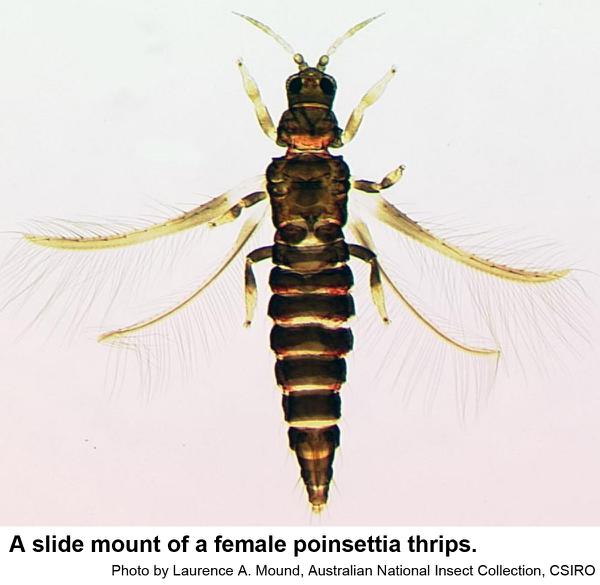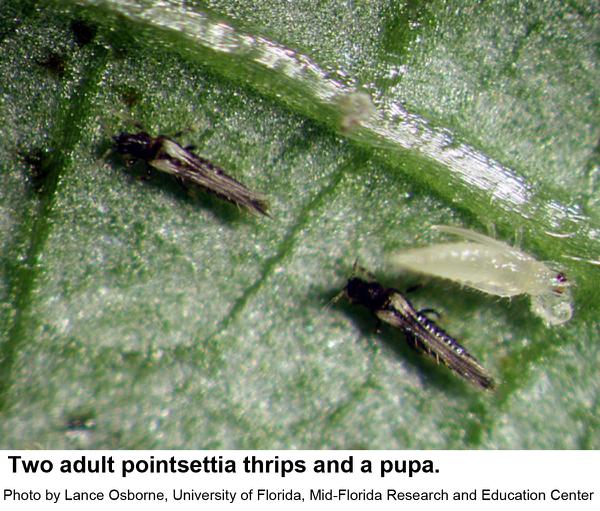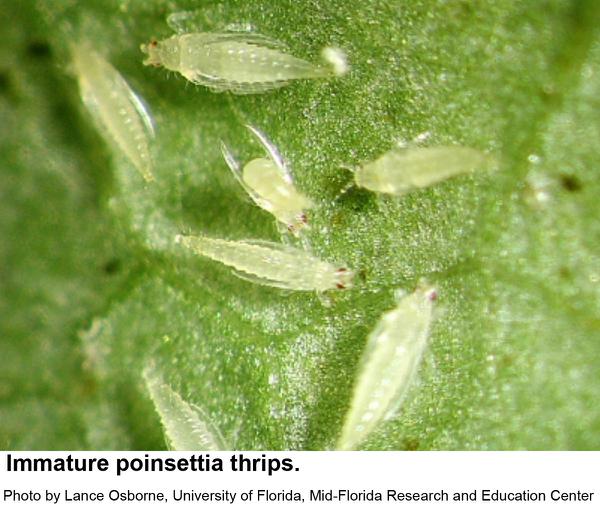Description and Biology
The poinsettia thrips, Echinothrips americanus, is a relatively dark thrips that is also called the impatiens thrips. Females are about 1/16 inch long, slender, and have two pale spots or bands on the wings. Males are somewhat smaller. The legs are dark near the body and pale at the extremity, and the antennae are pale. Immatures are also slender, very pale, and have bright red eyes. Although this thrips is found throughout much of the eastern United States, it tends to be a pest species only in the southern part of its range. This thrips deposits eggs randomly inside leaf tissue. Larvae hatch and develop through two stages before molting into prepupal and then pupal stages. A new generation of adults emerges from the last pupal stage in 12 to 33 days after the eggs were laid. Poinsettia thrips is relatively sluggish and apparently does not spread rampantly throughout a new environment unless blown in on prevailing breezes. It also tends to stay in the lower portion of plants.
Host Plants
Obviously poinsettia and impatiens are hosts of poinsettia thrips, but it also infests Irish shamrock, chrysanthemum, witch hazel, and many other plants. An experiment in Georgia showed that this thrips reproduced successfully on 99 cultivated and feral plant species. Thrips damage may resemble sun scald, but thrips and their excrement are easily recognized when infested leaves are turned over to reveal the lower surfaces.
Residential Recommendations
Poinsettia thrips is not resistant to pesticides perhaps because of its large feral population that is never sprayed with insecticides. Horticultural oil and insecticidal soaps give adequate control of thrips. Most of the insecticides labeled for residential landscape use should also give more than adequate suppression. This pest and other thrips species fly, and because of their small size they can be blown for long distances. Once thrips have been treated, would be well to keep an eye on susceptible plants. Don't spray flowers.
References
- Echinothrips americanus, a thrips of increased significance on ornamentals.Oetting, R. D. 1987. Proceedings of the 32nd Southern Nurserymens' Association Research Conf: 194-5.
- Insect and Related Pests of Flowers and Foliage Plants. Baker, J. R. ed. 1994 (revised). NC Cooperative Extension Service pub. AG-136.
- Poinsettia thrips Fact sheet, Anonymous. No Date. Plant Health Australia.
- Poinsettia thrips. Rosetta, R. 2014 (last modified). Pacific Northwest Nursery IPM, Oregon State University.
- Extension Plant Pathology Publications and Factsheets
- Horticultural Science Publications
- North Carolina Agricultural Chemicals Manual
For assistance with a specific problem, contact your local Cooperative Extension Center.
This Factsheet has not been peer reviewed.
Publication date: March 9, 2018
Reviewed/Revised: Aug. 12, 2021
Recommendations for the use of agricultural chemicals are included in this publication as a convenience to the reader. The use of brand names and any mention or listing of commercial products or services in this publication does not imply endorsement by NC State University or N.C. A&T State University nor discrimination against similar products or services not mentioned. Individuals who use agricultural chemicals are responsible for ensuring that the intended use complies with current regulations and conforms to the product label. Be sure to obtain current information about usage regulations and examine a current product label before applying any chemical. For assistance, contact your local N.C. Cooperative Extension county center.
N.C. Cooperative Extension prohibits discrimination and harassment regardless of age, color, disability, family and marital status, gender identity, national origin, political beliefs, race, religion, sex (including pregnancy), sexual orientation and veteran status.



